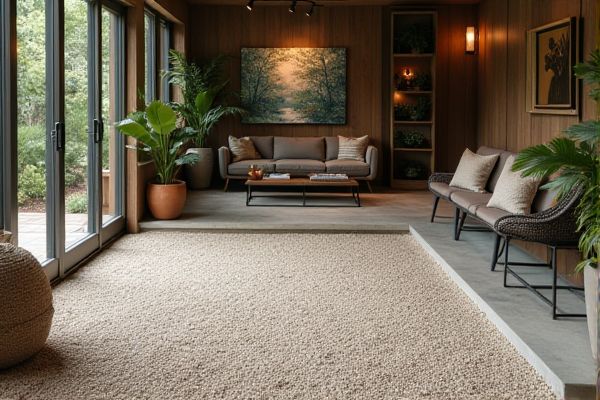
Gravel flooring offers a cost-effective, natural look with excellent drainage and easy installation, while paver flooring provides a more durable, structured surface perfect for driveways and patios. Discover which option best suits your outdoor space needs by reading the rest of the article.
Table of Comparison
| Feature | Gravel Flooring | Paver Flooring |
|---|---|---|
| Material | Natural crushed stones or pebbles | Concrete, stone, or brick pavers |
| Installation | Easy, quick, low-cost | Moderate difficulty, requires leveling and base prep |
| Durability | Moderate; may scatter or shift over time | High; stable and long-lasting |
| Maintenance | Low; occasional raking and topping up | Low to moderate; cleaning and joint resealing |
| Drainage | Excellent water permeability | Good, may require drainage system |
| Aesthetics | Natural, rustic look | Varied designs and colors available |
| Cost | Lower initial cost | Higher initial investment |
| Best Use | Garden paths, informal areas | Driveways, patios, walkways |
Introduction to Gravel and Paver Flooring
Gravel flooring consists of small, loose stones that provide excellent drainage and a natural, rustic aesthetic ideal for gardens and outdoor paths. Paver flooring uses interlocking concrete, stone, or brick units, offering durability, uniformity, and a wide range of design options for patios, driveways, and walkways. While gravel is cost-effective and easy to install, pavers provide greater stability and long-term maintenance benefits.
Material Composition and Characteristics
Gravel flooring consists of loose aggregates of small stones that offer excellent drainage and a natural, rustic appearance, while paver flooring is made from concrete, brick, or stone units designed for durability and uniformity. Gravel is flexible and easy to install or repair but can shift under pressure, whereas pavers provide a stable, hard surface resistant to wear and can accommodate heavy foot or vehicle traffic. Your choice depends on the balance between natural aesthetics with minimal maintenance (gravel) and structured, long-lasting surfaces requiring more installation effort (pavers).
Installation Process Comparison
Gravel flooring installation involves spreading and compacting a layer of crushed stone, typically requiring a simple base preparation and minimal tools, making it faster and more cost-effective. Paver flooring installation demands precise base preparation with gravel and sand layers, followed by careful placement of individual paving stones and joint filling, resulting in a more labor-intensive and time-consuming process. The durability and design flexibility of pavers justify the longer installation time compared to the quicker, low-maintenance gravel flooring setup.
Durability and Lifespan
Gravel flooring offers moderate durability, typically lasting 5-10 years before needing replenishment due to displacement and compaction, while paver flooring boasts superior durability with a lifespan of 25-50 years when properly installed and maintained. Pavers resist cracking and weather damage better than gravel, making them ideal for high-traffic or load-bearing areas. Your choice between gravel and pavers should consider long-term maintenance efforts and the expected durability based on environmental conditions.
Maintenance Requirements
Gravel flooring requires regular raking and occasional replenishment to maintain an even surface and prevent weed growth, making it a low-cost but ongoing maintenance option. Paver flooring demands periodic cleaning and sealing to protect against stains, shifting, and weed intrusion between joints, offering a more durable but higher-maintenance surface. Your choice depends on whether you prefer a natural, flexible ground cover or a stable, structured pathway with defined upkeep needs.
Cost Analysis: Gravel vs Paver
Gravel flooring offers a cost-effective solution, typically priced between $1 to $3 per square foot, making it an affordable choice for large areas or budget-conscious projects. Paver flooring, with material and installation costs ranging from $10 to $30 per square foot, involves higher upfront expenses but provides greater durability and aesthetic appeal, potentially increasing your property's value. When deciding between gravel and pavers, weigh initial costs against long-term benefits, maintenance requirements, and the intended use of your outdoor space.
Aesthetic Appeal and Design Options
Gravel flooring offers a natural, rustic aesthetic with varied textures and colors that complement outdoor garden paths or casual patios, providing flexibility in organic, free-form designs. Paver flooring delivers a polished, structured look with uniform shapes and a wide range of materials, including concrete, brick, and stone, enabling intricate patterns and customized layouts for driveways, terraces, and walkways. Both options allow for unique landscaping styles, with gravel emphasizing simplicity and permeability, while pavers offer durability and precise aesthetic control.
Drainage and Environmental Impact
Gravel flooring offers superior drainage due to its permeable nature, allowing water to quickly seep through and reduce runoff. Paver flooring, while providing moderate drainage through gaps or joints, often requires additional permeable materials or design considerations to manage water effectively. Environmentally, gravel is a more sustainable choice as it minimizes soil erosion, promotes groundwater recharge, and typically involves lower carbon emissions in production compared to the manufacturing of concrete or clay pavers.
Suitability for Different Spaces
Gravel flooring offers excellent drainage and a natural aesthetic, making it ideal for garden paths, driveways, and informal outdoor areas. Paver flooring provides a durable, flat surface suitable for patios, walkways, and high-traffic zones, supporting heavier loads and easier maintenance. Selecting between gravel and pavers depends on the desired functionality, appearance, and the specific environmental conditions of the space.
Pros and Cons Summary
Gravel flooring offers excellent drainage, cost-effectiveness, and easy installation but requires regular maintenance to manage displacement and weed growth. Paver flooring provides durability, low maintenance, and enhanced aesthetic appeal, though it involves higher initial costs and more labor-intensive installation. Both options suit different landscaping needs, with gravel favored for natural, flexible surfaces and pavers ideal for permanent, structured patios or walkways.
 homyna.com
homyna.com